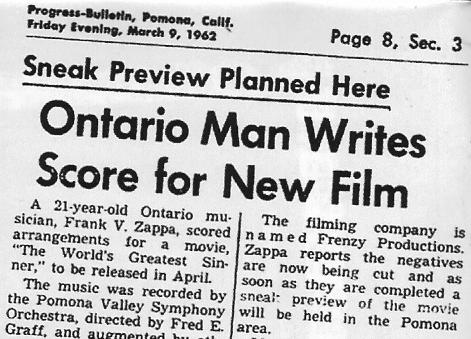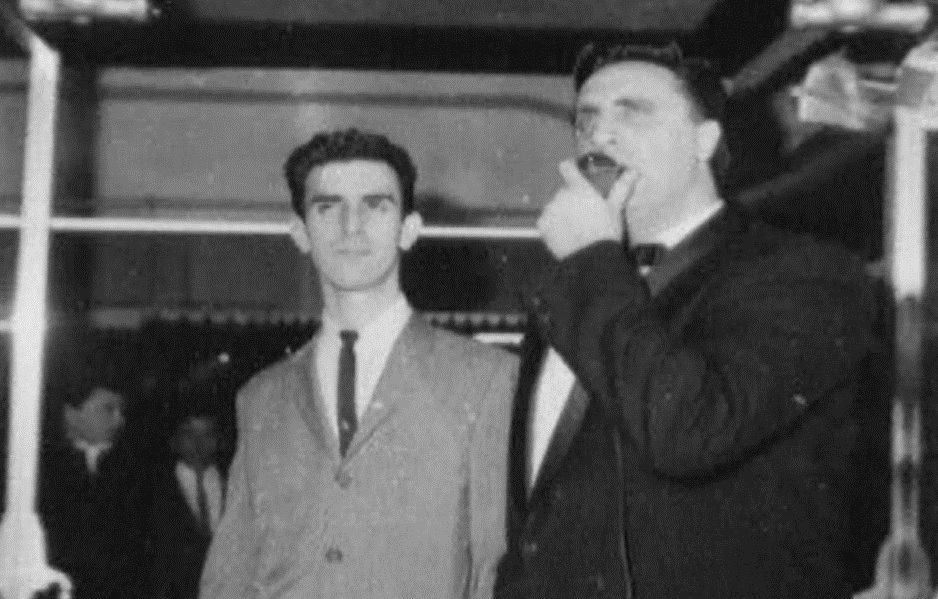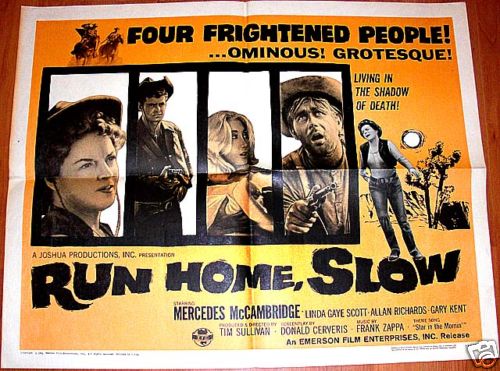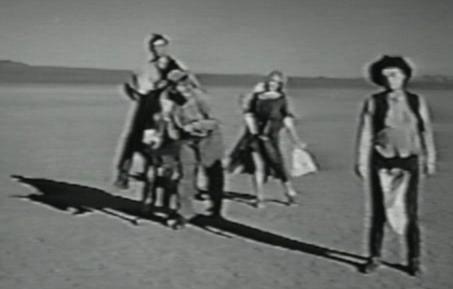THE MYSTERY DISC #1: MOVIE SCORES
 The first opportunity for having his music performed presented itself in the shape of
movie scores. In 1959 he reached an agreement with Don Cerveris, his English teacher on high
school. Cerveris had written a script for a cowboy movie and Zappa would write the scores for the soundtrack.
Because the film couldn't get sufficiently financed, this idea got postponed.
The first opportunity for having his music performed presented itself in the shape of
movie scores. In 1959 he reached an agreement with Don Cerveris, his English teacher on high
school. Cerveris had written a script for a cowboy movie and Zappa would write the scores for the soundtrack.
Because the film couldn't get sufficiently financed, this idea got postponed.
The world's greatest sinner
In 1961 a second chance came up for writing the score for a low budget movie called "The world's greatest sinner",
a Timothy Carey project.
In December 1961 the recordings of the orchestral parts took place with the Pomona Symphony Orchestra. No tracks from these recordings have appeared on CD,
but the title track - a rock band blues song - was released as a single in 1963 (it's unclear in what form it was used for the movie,
the video version apparently doesn't include it). It's blues in A Mixolydian with in the transcription below the standard blues
chord scheme included once:
- bars 1-8: intro. Bars 1-4 are playing around the A#m-5 chord, bars 5-8 switch to A Mixolydian.
- bars 9-12: I.
- bars 13-14: IV. The C becomes natural, switching to the A Dorian scale.
- bars 15-16: I.
- bar 17: V (only implied).
- bar 18: IV.
- bar 19: I (return to I in A Mixolydian, after two bars of I the scheme restarts.)
The world's greatest sinner, single (midi file).
The world's greatest sinner, single (transcription).
Zappa kept playing blues every once in a while throughout his career. See the Bongo fury section halfway this study
for more on this topic. "The world's greatest sinner" was
presented in 1962, but only reached some cult status (see www.imdb.com/title/tt0056703 and
www.absolutefilms.net/videosale.html for information about this movie). It's available on video and hopefully coming up
on DVD shortly, because both the soundtrack and the movie deserve closer attention. Zappa was twenty when he wrote the score
in the summer of 1961 and it shows that he indeed started out as a composer of modern music. It's functional music for a movie
and professionally done, indicating how much Zappa had learned via classes and self-education. He gets often quoted for
saying that he shortly went to the Chaffey Junior College for meeting girls, his only formal semester of education after
high school. That's only half of the truth. He did indeed meet his first wife Kay Sherman there, but he was also known as an
ardent student. He quit school when he found that he had learned enough. Presented below are three sections
from the soundtrack.
The first is a little piece of parade music in a modern style, where he's toying with intervals:
- bars 1-2: the first theme by the woodwinds is played with parallel minor seconds.
- bars 3-6: the second one by the brass is played consonant intervals between the lines (fourths and thirds in staffs 3-4),
combined with a bass D as pedal note by the timpani and a B in the descant (staff 5).
Whereas bars 1-2 are atonal, this section can be seen as in D (theoretically it can also be identified as D Lydian, because the G/G#, that
makes the difference, fails).
- bars 7-8: a variation upon the first theme.
- bars 9-10: a theme played via syncopic triplets and varying intervals. Again bars 7-8 are atonal and
bars 9-10 in D for its bass D by the timpani.
The world's greatest sinner, soundtrack excerpt #1 (midi file).
The world's greatest sinner, soundtrack excerpt #2 (midi file).
The world's greatest sinner, soundtrack excerpt #3 (midi file).
The world's greatest sinner, soundtrack excerpts (transcriptions).
 There are some five minutes
of various forms of such modern music with percussion parts, dissonants and rhythmic variation to be found in the score. The second example is played very slowly
during a funeral scene in the movie. In bars 6-7 it includes a motif that returns at the beginning of the third
example. This last one stems from the end. The lead melody is in traditional romantic style, the harmonies are free, sometimes
traditional, sometimes more modern. This whole block, the romantic style and the well sounding orchestration in a traditional
sense, is quite exceptional in Zappa's oeuvre. The meters in these last two examples are either regular 4/4 or strings of
notes in odd numbered ones as 11/8. Harmonically the material is evidently diatonic, using notes from one or two
closely related scales. They can hardly be assigned to keys. The first one contains no harmonic cadences in it and pedal notes are only
held shortly or not present at all. The second one does use chords, but in such a way that the piece keeps drifting
instead of confirming a key note.
There are some five minutes
of various forms of such modern music with percussion parts, dissonants and rhythmic variation to be found in the score. The second example is played very slowly
during a funeral scene in the movie. In bars 6-7 it includes a motif that returns at the beginning of the third
example. This last one stems from the end. The lead melody is in traditional romantic style, the harmonies are free, sometimes
traditional, sometimes more modern. This whole block, the romantic style and the well sounding orchestration in a traditional
sense, is quite exceptional in Zappa's oeuvre. The meters in these last two examples are either regular 4/4 or strings of
notes in odd numbered ones as 11/8. Harmonically the material is evidently diatonic, using notes from one or two
closely related scales. They can hardly be assigned to keys. The first one contains no harmonic cadences in it and pedal notes are only
held shortly or not present at all. The second one does use chords, but in such a way that the piece keeps drifting
instead of confirming a key note.
Image all above to the right: head of an article in a Pomona newspaper
about the recording of the music for "The world's greatest sinner".
Source: "The mystery disc" booklet. Image to the right: Zappa and Timothy Carey (https://thetimothycareyexperience.com).
Holiday in Berlin
The soundtrack from "The world's greatest sinner" includes two of the four themes that would later on constitute the "Overture to Holiday in Berlin". It forms
part of a chain of themes. With the earlier Mothers of Invention, Zappa would often play his themes live in a medley like form,
often with solos in between them. He's even reported to drive some of his musicians nuts by coming up with new constructions
day after day. I can't verify that in detail. Next, however, are the set ups of three "Holiday in Berlin" sequences from about 1968-1970:
- Burnt weeny sandwich: Overture to a Holiday in Berlin
0:00 Theme 1 (see below).
0:24 Theme 2 (see "Overture to a Holiday in Berlin" from the Burnt weeny sandwich section
of this study).
0:35 Theme 3 (idem).
0:48 Theme 1.
1:00 Theme 4 (see below).
1:27 End
- Burnt weeny sandwich: Holiday in Berlin (full blown)
0:00 Block 1. This is the block that gets reused for the "Overture" and "Would you like a snack?" sections from "200 Motels" in
orchestral variations/re-orchestrations. See the 200 Motels section for note examples.
0:46 Block 2. The themes from the Overture return.
Holiday in Berlin, themes 1 and 4 (midi file).
Holiday in Berlin, themes 1 and 4 (transcription).
- Theme 1. First theme from the transcription in D, being the main theme from "The world greatest sinner".
Rhythmically this theme is in straightforward 3/4.
- Theme 4. Second theme from the transcription in D Lydian, originating from "The world greatest sinner".
It's played over a steady bass figure, basically giving a D as pedal note. Rhythmically it's the opposite of the first theme: the lengths of the notes
keep varying in an irregular way, causing syncopic figures about half of the time. When this theme gets repeated the bass
turns into a little riff and accompanying chords get into the picture, played as parallel 5th chords with the third left out.
This theme can also be heard towards the end of "Jim/Roy", a track from "The mystery disc". On that occasion Roy Estrada is singing the tune
over arpeggio piano chords. "Jim/Roy" overlaps with tracks 4-6 from "Ahead of their time".
2:57 Block 3. Solo in D Lydian with the bass alternating D and E. See
"Holiday in Berlin (full blown)"
from the Burnt weeny sandwich section of this study for the opening of this solo.
6:23 End.
- Tenga na minchia tanta from Beat the boots: tracks 12-13
The sound quality of this semi-officially released bootleg is acceptable, so the word bootleg in this specific case
doesn't have to scare you off. These two tracks are of specific interest, first because of the lyrics added to them. They fit in thus
well, that it looks as if the song was composed that way, whereas in reality they were added later on. The composition
was never called "Holiday in Berlin" from the beginning. Secondly the guitar solo is great. The title "Inca roads/Easy meat",
that the bootleggers gave it, is not really wrong, though unlucky. Because the intro and the solo are in D Lydian with the same basic two chord alternation as on "Burnt weeny
sandwich", it better could have been listed as a Holiday in Berlin solo.
0:00 Track 12. "Shark, shark, shark" theme from "Fillmore east".
0:38 "Rance Mohammed" bridge of some drumbeat bars.
0:45 Block 1. As above, now with lyrics as on "200 Motels".
1:55 Block 2. Idem, the lyrics refer to the revolting Berlin students during a Mothers concerts.
4:36 End of track 12.
0:00 Track 13. This whole track represents what is block 3 from above with new elements added to it.
It starts with a chord alternation of D and E over which Flo and Eddy are improvising.
0:43 Vocal version of one of the later "Inca roads" themes.
1:24 Another solo in D Lydian starts. See the Fillmore East 1970 section for examples from this
"solo from Holiday in Berlin".
6:22 Coda.
7:16 End of track 13.
Run home, slow
 Things were coming off in 1963. Several singles were released (see also the next section) and
Zappa could return to the cowboy motion picture, called "Run home, slow", that now had reached
an adequate
budget. Mercedes McCambridge would be the protagonist (see www.imdb.com/title/tt0059663 for this movie).
To the left a poster, copyright Joshua productions/Emerson film enterprises. Vaguely legible is "music by Frank Zappa".
Things were coming off in 1963. Several singles were released (see also the next section) and
Zappa could return to the cowboy motion picture, called "Run home, slow", that now had reached
an adequate
budget. Mercedes McCambridge would be the protagonist (see www.imdb.com/title/tt0059663 for this movie).
To the left a poster, copyright Joshua productions/Emerson film enterprises. Vaguely legible is "music by Frank Zappa".
For the same year Zappa had organized a one time performance of some of his modern
music pieces at the Mount St Mary's College, that was broadcast on a local
radio station: "Mount St. Mary's was the first time I had a concert of my music. As
with most other concerts of my [modern] music, I had to pay for it... That was 1962. That was a
bargain, though, because it was only $300. It was a student orchestra. There were probably about fifty
people in the audience, and - for some strange reason - KPFK taped it, and I got a copy...
There was one thing called "Opus 5", and there were aleatoric compositions that involved a certain amount of improvisation, and there were some written sections
that you actually had to play. Some of the things were graphic, and there was a tape
of some electronic music that was being played in the background with orchestra, and I had some 8mm films
that were being projected" (Zappa!, page 55). The event seems to have had a duration of 70 minutes
and an excerpt of 2:28 minutes has appeared on in the posthumously
released CD "The Lost Episodes" (1995).
This last CD and "The mystery disc" (1998) also contain sections from "Run home, slow", while "You
can't do that on stage anymore, vol. V" has a 1969 performance of "The little march"
from "Run home, slow" included. The melody of the "Running Home Slow Theme" and its variation, played in the second half, are given beneath. Played against a steady rhythmic figure in 3/4 the melody itself has an irregular rhythm, giving it a jazzy, quasi-improvised character. The rhythm includes several syncopes and two polyrhythmic bars with two played over three.
Run home, slow, melody (midi file).
Run home, slow, variation (midi file).
Run home, slow, melody, variation and accompanying figures (transcription)
The opening melody is played along a pentatonic scale, that uses, beginning with the lowest note, the row A, B, C sharp, E, F sharp. Melodies along such a scale have a smooth consonant progression, because there are no minor seconds in the scale. Zappa opposes this smoothness in the second half of the piece by giving a dissonant variation on the theme along a self-created scale with many minor seconds in it. This scale is A sharp, B, C, E, F, G flat, A flat with four minor second intervals in it. Contrary to the opening melody, the accompanying figure now doesn't fit in the same scale.
Run home cues #2 (midi file).
Run home cues #3 (midi file).
The little march, opening (midi file).
Run home cues #2 (transcription).
Run home cues #3 (transcription/sketch).
The little march, opening (transcription).
Apart from the theme, two other small excerpts are included in "The lost episodes", called
"Run home cues #2" and "#3", while "The mystery disc" includes the original "Duke of prunes"
theme from the movie, that would later appear on "Absolutely free" and "Orchestral favorites"
(see the corresponding section). YCDTOSA V has the theme played live and "The little march".
"Run home cues #2" is a gentle little adagio outtake that varies a chord progression, C-Gm7-"G", rhythmically and harmonically. The third chord turns up in two different forms and holds
a somewhat ambiguous position. First as Gsus2 in bar 3, next as a triad in bar 6. In bar 6 the B turns up as natural, so now it gets to sound as evading from the initial G Dorian scale.
"Run home cues #3" is a clear reference to Stravinsky's "Rite of the spring", starting with the
uptight beating of a dissonant chord in a varying rhythm. The timpani is ticking eighth notes steadily, but the dissonant chord
appears in different positions. This figure lasts 10/4 in total. Probably Zappa's original score has this figure subdivided into two or more bars,
but straight from CD it's getting arbitrary to say how. Next the music evolves into some
relaxing bars in D Mixolydian with a Cmaj7 chord moving over to a D chord. It's not the standard resolving chord (C), but
it does resolve the dissonance of the Cmaj7 chord in a way. Again I can't get to a proper meter notation, this time due to the rubato manner
it's being played with.
"The little march" is more remindful of Stravinsky's friendly melodic side. Zappa included a rock band execution
of the "Royal march" from Stravinsky's "A soldier's tale" on "Make a jazz noise here". Almost thirty years after
the "Little march" recording, Zappa presented another less short march to the Ensemble
Modern, called "This is a test", originally called "Stravinsky" (see the Yellow shark section). These two pieces
have in common that the scales keep changing and that key notes are mostly absent, so they are marches with a modern flavour.
Zappa did several references to Stravinsky in his career. In "Status back baby" from
"Absolutely free" (1967) he's quoting some bars from Petroushka. A small section of this ballet was also
performed live, as presented on the "'Tis the season to be jelly" bootleg from the same year.
In 1977 Stravinsky became part of Zappa's on stage comedy acts. During "Titties and beer" the devil, in his
conversation with Zappa the biker, attempts to verify his main interest:
FZ: I'm only interested in two things. Let me see if you can guess what they are.
Devil: Well uh...uh, maybe Stravinsky.
FZ: I'm only interested in two things: titties and beer, titties and beer, titties and beer.
Devil: Wrahhh. I think I've come to the wrong guy.
 The "Run home, slow" movie itself is an almost forgotten cowboy movie, cheap in various senses, though
not as bad as it is mostly reported to be.
It starts with villagers capturing and hanging a local villain Hagen. His three adult children,
Nell, Ritt and a hunch-back retard Kirby seek revenge. First they rob the local bank. This would require
some action and only gets spoken of, just to indicate how low the budget was. Next they come after the man they
hold responsible for organizing the hanging and a little shoot out follows. Ritt gets wounded and they lose their horses. Trying to escape
from a posse chasing them, they have to continue on foot through the desert, accompanied by Ritt's frivolous wife Julianne.
The group finds haven in a deserted farm house, where things are going from bad to worse.
The film has some thirty minutes accompanied by music by Zappa, including repetitions and a sung motif. The soundtrack contains various variations upon material
from "Duke of prunes" and "The little march", as well as longer parts of background music
for movie sceneries.
The "Run home, slow" movie itself is an almost forgotten cowboy movie, cheap in various senses, though
not as bad as it is mostly reported to be.
It starts with villagers capturing and hanging a local villain Hagen. His three adult children,
Nell, Ritt and a hunch-back retard Kirby seek revenge. First they rob the local bank. This would require
some action and only gets spoken of, just to indicate how low the budget was. Next they come after the man they
hold responsible for organizing the hanging and a little shoot out follows. Ritt gets wounded and they lose their horses. Trying to escape
from a posse chasing them, they have to continue on foot through the desert, accompanied by Ritt's frivolous wife Julianne.
The group finds haven in a deserted farm house, where things are going from bad to worse.
The film has some thirty minutes accompanied by music by Zappa, including repetitions and a sung motif. The soundtrack contains various variations upon material
from "Duke of prunes" and "The little march", as well as longer parts of background music
for movie sceneries.
Run home, slow, soundtrack excerpt #1 (midi file).
Run home, slow, soundtrack excerpt #2/Right there riff (1963) (midi file).
Run home, slow, soundtrack excerpt #3 (midi file).
Run home, slow, soundtrack excerpt #4 (midi file).
Run home, slow, soundtrack excerpts (transcriptions).
Above are four excerpts from the soundtrack that haven't been released on CD, at least not in this form. The first sample is played a couple of times
during the movie. It's build over two large 11th chords in E Dorian. They are played as arpeggios and keep alternating.
Over these two chords a short melancholic melody is played, depicting the depressing tone of the movie. It's related
to "The original duke of prunes" in the sense that the latter is also a slow melody played over two alternating arpeggio
chords (see the Orchestral favorites section for more). The second example is a merry little march of two short themes,
each of one bar. Both themes exist in two variants,
slightly different from each other. In a faster version it's known as the riff from "Right there"
("You can't do that on stage anymore, vol. V"). It's also present in both a slow and fast tempo during "Skweezit skweezit skweezit"
on "The mystery disc", a different performance of "Right there", also recorded life in 1969. Bars 1-2 of this riff have a chromatic element in it with the descant downwards movement
D-C#-C natural-B. Bars 3-4 stay in one scale except for the F going to an F# at the end. A key note can't be identified.
The third excerpt is functional music for a movie scene, rendering an
atmosphere of isolation when the Hagen family is passing through the desert on foot (image above, Joshua productions).
It's accomplished by atonal modern ensemble music in a slow hocketing style. The last example is a larger three-part melody in strict 3/4,
dealing with refined harmonies. The bass line is a direct part of the harmony, being in the same rhythm. Sometimes
it does this via a direct parallel movement,
sometimes by following a counterpoint line and sometimes by building an arpeggio chord. The oboe is playing long held soft notes over the other two parts, becoming louder
towards the end. In bar 1 this miniature starts off quite normal with a sequence of 5th chords in E Dorian; bar 2
is also made up of 5th chords. From bar 3 onwards things are gradually becoming more volatile. 7th and larger chords enter
the picture, or chords with passing-through notes, depending on how you would like define things.
Notes become natural and sharp again. The melody sometimes jumps, for larger parts it moves as a wave.
Both above soundtracks are uneasy to obtain. Apart from the "Run home, slow" examples on his own CDs,
most Zappa fans only know of the existence of these scores. As for most of his projects,
each one brings out new aspects of his musical horizon, and this also applies to these two early ones. I only got
to know these works better in 2008, being a sort of revelation.
Other tracks from The mystery disc
The music from "The mystery disc" was originally released in the shape of two bonus albums for "The old masters vol. I and II". In 1998 it was
released by the Zappa Family Trust (ZFT) as an individual CD. Tracks from this CD are coming by in this section and the Projects section. In
total the following songs are included in this study, next to the tracks from above:
- "Original Duke of prunes": this piece gets dealt with in the Orchestral favorites section.
- "I was a teenage maltshop": the demo for this opera gets described in the Projects section.
- "Metal man has won his wings": another blues improvisation with Don Van Vliet, included in the Paul
Buff section.
- "Bossa Nova pervertamento": this title is included in the same section.
- "Speed-freak boogie": two examples from this solo are included in the Paul
Buff section.
- "Mondo Hollywood": an excerpt from this solo is included in the Projects section.
- "Agency man": the opening of this song gets dealt with in the Ahead of their time section.
- "Piece one": a small outtake is also present in the Ahead of their time section,
on this CD re-titled as "Like it or not".
- "Piece two": idem, now re-titled as "Undaunted, the band plays on".
